A Simulationist's Framework
for Business Analysis
Part 06:
Approach Contexts for Potential Solutions
R.P. Churchill
CBAP, PMP, CSPO, CSM, CSDLean Six Sigma Black Belt
www.rpchurchill.com/presentations/TWSLseries/06_Approaches
www.rpchurchill.com | Portfolio | Presentations
30 Years of Simulation
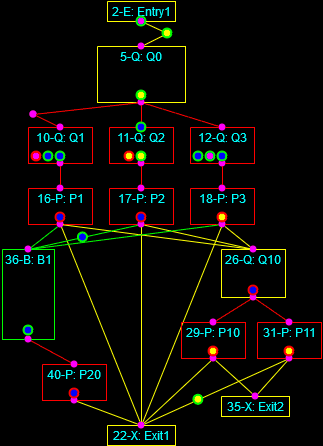
Continuous simulation of the heating of a square billet and Discrete-Event simulation of a multi-phase process.
30 Years of Simulation
|
Industries
|
|
|
Examples of Benefits Realized
The following items come from near the top of the landing page for my website:
- Automation saved 10% on fuel costs for gas-fired steel reheat furnaces and saved 30% on personnel costs for a disability insurance underwriting department.
- Moving implementations to lower-cost and more readily available hardware and software platforms saved up to 70% on procurement costs and improved maintainability and standardization.
- Thorough discovery and data collection efforts led to accurate simulation of systems for sizing, process improvement, and design; accurate and effective troubleshooting; and complete, robust solution designs.
- Effective system decomposition led to modular, flexible, understandable, robust, maintainable solutions.
- Developing custom tools for ongoing budget oversight led to effective predictive and Earned Value management of projects and programs.
- Powerful user interface designs gave users effective and accurate control of systems.
- Detailed and creative graphic displays and animations provided users with enhanced understanding and situational awareness.
- In-depth technical experience and a willingness to help others has led to successful onboarding, training, mentoring, and support of numerous individuals in many environments.
- Reverse-engineering led to effective and cost-efficient maintenance of existing software systems and understanding needed to implement modernized replacements.
- Application of efficient numerical methods for engineering calculations led to faster systems that could offer advanced calculations for real-time training and industrial control.
- Analysis and conditioning of large data sets allowed them to be used as inputs and effectively interpreted as outputs for detailed tradespace studies and other applications.
- Site operational audits showed that contractual production volume and quality requirements were being met.
- A wide range of test, verification, validation, and acceptance and accreditation methods demonstrated that software systems were implemented correctly and could be safely and effectively employed for their intended use.
The Framework:
- Project Planning
- Intended Use
- Assumptions, Capabilities, Limitations, and Risks and Impacts
- Conceptual Model (As-Is State)
- Data Sources, Collection, and Conditioning
- Requirements (To-Be State: Abstract)
- Functional (What it Does)
- Non-Functional (What it Is, plus Maintenance and Governance)
- Design (To-Be State: Detailed)
- Implementation
- Test
- Operation, Usability, and Outputs (Verification)
- Outputs and Fitness for Purpose (Validation)
- Acceptance (Accreditation)
- Project Close
The Framework: Simplified
 Intended Use
Intended Use Conceptual Model (As-Is State)
Conceptual Model (As-Is State) Data Sources, Collection, and Conditioning
Data Sources, Collection, and Conditioning Requirements (To-Be State: Abstract)
Requirements (To-Be State: Abstract)- Functional (What it Does)
- Non-Functional (What it Is, plus Maintenance and Governance)
 Design (To-Be State: Detailed)
Design (To-Be State: Detailed) Implementation
Implementation Test
Test- Operation, Usability, and Outputs (Verification)
- Outputs and Fitness for Purpose (Validation)
Continuous Iteration and Correction
Regardless of the structure of the engagement, the activities in each phase are carried out in an iterative fashion that continuously incorporates review, feedback, and correction both within and between phases.

Link to detailed discussion.
Basic Engagement Structures

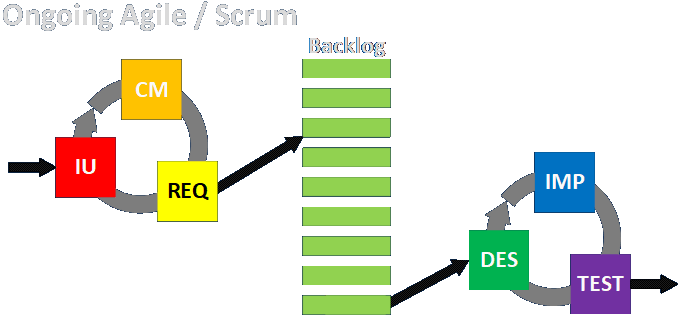

Link to detailed discussion.
Engagement Structure Variations



Link to detailed discussion.
Tracking Across the Engagement
Items are tracked using a Requirements Traceability Matrix.
Omissions recognized in later phases can cause items to be created in earlier phases.
Procedural requirements may apply to each phase.
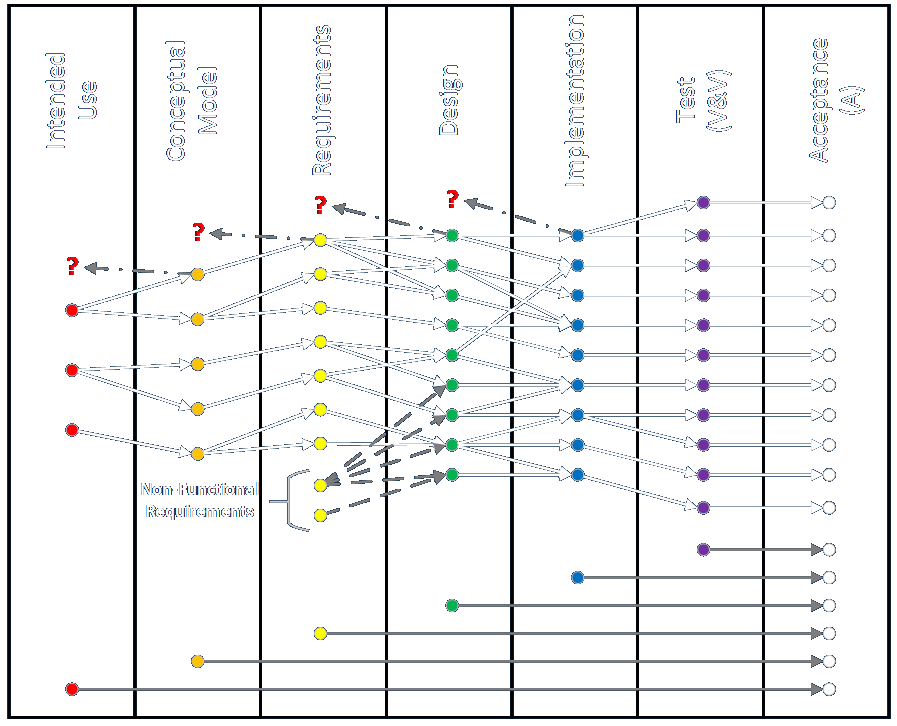
Link to detailed discussion.
Extended Project / Program / Product Framework
Once a system is implemented, deployed, and accepted, it may be used, maintained, and modified over a long period of time, until it is removed and possibly replaced.
Ongoing modifications to an existing system will involve engagements with an existing As Is state which may have to be "re-discovered."
Ideally, ongoing work will be integrated and linked into the original project's core documentation.
 Operation and Maintenance
Operation and Maintenance End-of-Life and Replacement
End-of-Life and Replacement

Link to detailed discussion.
Engagement vs. System vs. Solution
The engagement is what we do to effect a change that serves customers.

The system is what we analyze and either build or change to serve customers.
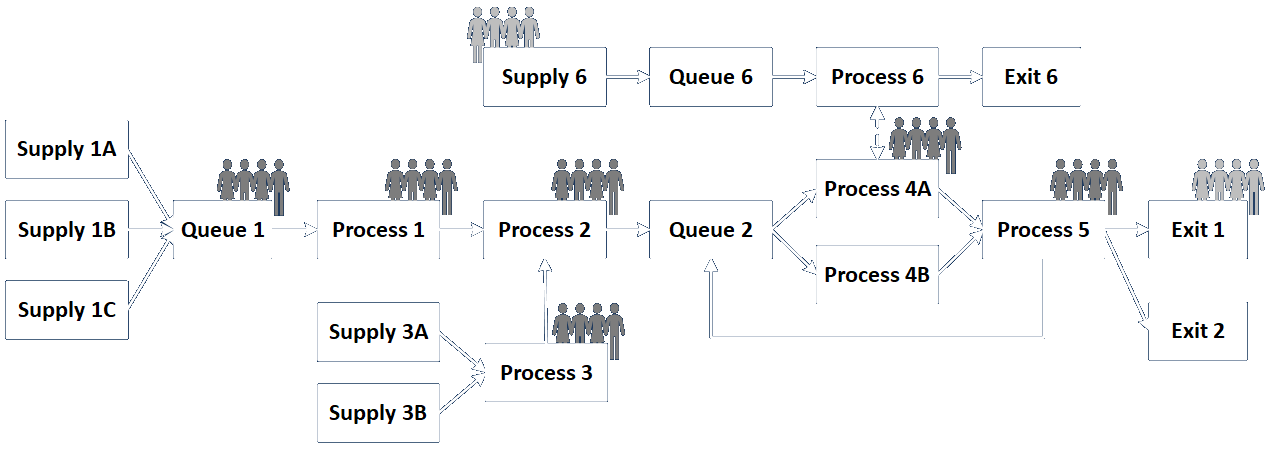
The solution is the change we make to serve customers (and may involve a process, product, or environment).
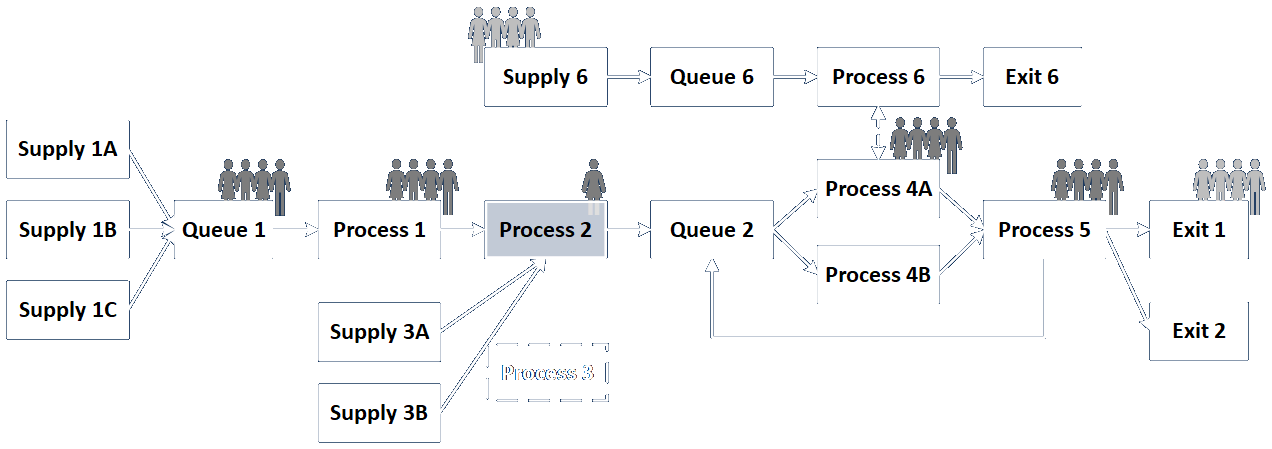
What are some things we think about when creating solutions?
Sometimes the solution is pretty obvious, and then it's just a question of executing it. But not every problem can be solved the same way.
One or two of the following considerations may be the main drivers, but several others may also come into play during a given engagement.
Different organizations (including departments within organizations) may be driven by different approaches.
Different approaches may be applied during new builds and modifications to existing systems.
Some of these approaches may overlap or otherwise appear very similar to each other. I would love to hear your thoughts on how the list might be improved.
Link to detailed discussion.
Internal vs. External Customers
Some aspects of the work, contracts, terms, and payments may be more formal when serving external customers.
Work for external customers will tend to come to a defined end. Ongoing development, maintenance, and improvement (especially in CI/CD environments) tend to be hallmarks of supporting internal customers.
Internal customers tend to get more open-ended solutions, while external customers tend to get more standard solutions.
An economic case must generally be made to justify work for all customers.
Standard Solution vs. Open-Ended Solution
A standard solution is one using the same approaches or tools. This is more specific than just saying you always use IT in some way. Standardized does not mean always exactly the same. Many customizations can be and are developed and deployed.
This usually has to do with the main business lines of an organization, in terms of both products and services.
I worked for vendors and consultants that specialized in:
- turnkey mechanical pulping systems for the paper industry (and process improvement consulting for same)
- nuclear power plant simulators (as a division of a larger industrial conglomerate)
- document imaging systems for business process reengineering efforts
- reheat furnaces and control systems for the metals industry (and control systems and process improvement consulting for that and related manufacturers)
- control systems for HVAC and building entry systems
- operations research simulations (usually for large government customers), and some related general IT solutions
I supported an internal, microservices-based, CI/CD, IT system in only one case.
Organizations that specialize in particular types of solutions will inevitably also address a variety of other random problems.
Imposed By Competition
Organizations should always try to proactively stay ahead of the competition, or at least keep up with it.
If you are responding rather than leading, you may be forced into hasty and ill-advised actions.
You don't always have to do a bunch of R&D, you just need to be aware of and make use of ongoing general developments.
If you don't keep learning, growing, and improving, your competitors probably will.
If you aren't actively trying to grow and improve, you've created a job and not a career (or a dynamic organization).
Opportunity From New Technology
Newly emerging tools and techniques often suggest better ways of doing things. (Copeland scroll, Polaris black box, computers for early simulations, booth swivel)
They allow things to be done better, faster, and cheaper, and also allow entirely new things to be done that never could be before.
Be alert to opportunities anywhere in your existing systems and processes. You don't always have to remake the world.
Be mindful of the Theory of Constraints: The Five Focusing Steps:
- Identify the constraint
- Exploit the constraint
- Subordinate to the constraint
- Elevate the constraint
- If constraint is "broken" go back to step 1
Making one thing better may move the bottleneck to a new place.
Automation
Automation usually means having some sort of machine perform an operation currently performed by a human.
Automation (orange line) has many potential benefits:
|
|

|
I have developed multiple systems to automatically generate code, complex mathematical functions, and simulations. That increases speed, consistency, and accuracy, and greatly reduces errors.
Standardization / Modularization
This involves many forms of doing things consistently.
Automation is a form of standardization but so is modularization.
Modularization means turning components (processes, code, and physical items) into standardized things that can be put together in different combinations in much the same way as pieces of Lego.
Affinity grouping (using Post-It notes) can help identify classes of items amenable standardization (and possibly configurable as well).
Working with modular components can lead to producing prefabricated items that can be assembled on site.
Replacing modularized components instead of directly repairing individual circuit components can simplify maintenance as well as construction and manufacturing.
Rearrangement or Streamlining
Putting operations in a different order — when it makes sense — can result in greater efficiency.
Relocating processes to be in physical proximity to each other eliminates transport time and handling. That said, organized queues can be included and sized to best react to planned and unplanned outages.
Processes can sometimes be combined, and you can even improve things by adding operations.
This is a form of Lean Engineering.
Redesigning processes using guides or jigs can make operations faster and more consistent. This concept also applies to IT and other situations where you structure the operation or interface in a way that speeds things up and reduces errors (e.g., UIs, equipment templates for different processes).
Lean vs. Six Sigma
Six Sigma is about reducing variation. This allows processes to produce results more repeatably within tighter tolerances, which reduces waste and improves quality.
Six Sigma (really 4 1/2 Sigma...) includes a lot of statistical techniques and can be seen as applying to higher-volume activities.
Lean engineering is about doing more with the same, or the same with less. It involves many of the other approaches listed here including modularization, rearrangement or streamlining, simplification, and so on.
I spent most of my career doing lean. Automation is Lean. Many forms of improving computer code are Lean. Some of the simulations I did supported Lean.
Each practice involves a large body of knowledge that includes a large number of techniques. High-level certifications are not easy to earn.
Profiling
This involves identifying where large amounts of resources are being devoted, and seeing if ways can be found to reduce the use of those resources.
I first encountered the idea as it applied to running computer code. Profilers would identify what sections of code were executed most often, so effort could preferentially be directed to making those more efficient.
Extreme loop unrolling is an example of making sections of code more efficient (in terms of speed, in a trade-off with code size and memory and storage use). (See story 2 here.)
This concept can be applied in many different ways. I know one individual who noticed that stainless steel was one of the major costs in his products, so he asked around and found that he could use a different grade of stainless steel that was cheaper than the industry standard, but performed just as well. He therefore saved his company — and his customers — a lot of money and stayed ahead of his competitors. Similarly, most efforts that try to reduce labor costs operate on the same principle.
Simplification
Making products simpler can make them easier to use and easier to produce.
Product lines can be extended with simpler options (which may or may not be desired).
Design for manufacturability is a major practice in this area.
I've watched certain products I use be continuously redesigned so they embody simpler shapes and include fewer parts. It can take a lot of experience and insight to see how to make something simpler.
One doesn't generally find the simplest, most optimal design on the first try. It takes iteration to get something to work and then successively improve it. In a market sense, it is sometimes less a case of "getting there first-est with the most-est" (as they say about wars) than about "getting there first-est with just-enough-est."
Incremental vs. The Big Kill
You can try to improve small things, like reducing a lot of small losses in a plant (using improved insulation, stopping leaks, reducing friction, and so on). By contrast, you can redesign the entire process using new technologies or techniques to realize quantum gains.
I learned about this in a class called Analysis, Synthesis, and Evaluation during my junior year in college. It took me a long time to understand some of the material in that course, but this concept was obvious the minute I heard it. I tend to look for the big kill whenever possible, but that doesn't mean the incremental improvements should be ignored.
Big Kill improvements require a lot of insights and may involve many other concepts on this list. They often require reframing the problem entirely.
Big Kill opportunities don't always exist, or may not be useful even if they do exist (e.g., for commodity products in declining industries.)
Conversely, organizations may be afraid to capitalize on Big Kill breakthroughs because they cannibalize existing businesses. (see: Kodak)
End-of-Life, Replacement, and Repurposing

Systems and processes age, during which time they may require increasing maintenance, may break more often, or may lose economic efficacy. Sometimes they have to be scrapped entirely, but there are other alternatives.
Systems can sometimes be upgraded so they will last longer or perform better.
Systems can be replaced with newer versions with higher capacity and better quality. (I created modern, Level 2 supervisory control systems for old and new furnaces.)
Systems can be repurposed to make other products. (I've seen old newsprint lines be converted to produce specialty tissue grades.)
Systems can be sold and transported to developing areas where, because they can be purchased for pennies on the dollar, they will be economically competitive.
Entirely New Solutions

|
|
This is a combination of other concepts that result in doing something an entirely different way. Identification of such solutions can arise through sudden, serendipitous insights, but those are rare and shouldn't be relied upon. If you're going to look for entirely new approaches, you should be prepared to perform a very thorough, purposeful, organized analysis that looks at every aspect of the problem from every angle. There are some formal ways to do this (e.g., UML, which need not apply only to IT systems), but anyone can be thorough. As mentioned in the idea of the Big Kill, you may have to reframe the problem and cut through to its core essence. You should probably also proceed from the inside out, and reconsider what the core product or benefit you're providing is. (Xerox famously reframed their value proposition from making copiers to managing documents in general. OTOH, they also didn't see the utility of the computer GUI they invented.) |
Improved Management Techniques
How processes are managed can yield major benefits.
Agile methodologies provide benefits when properly understood and implemented. They facilitate ongoing communication and prevent groups from going off and doing their own thing only to find out the pieces don't all fit together at the end.
Major breakthroughs have been made in reliability and maintenance, through the introduction of scheduled maintenance and condition-based maintenance. Modern instrumentation aids this greatly in some situations.
Just-in-time manufacturing is a management technique that doesn't change the physics or operations of the core process, but leverages information to reduce storage quantities and wait times to realize many different kinds of efficiency and cost savings.
General Technical Solutions
There are many kinds of miscellaneous technical tools that make people's work easier. Many involve basic kinds of software.
People use Excel for a myriad of different uses, which they may or may not outgrow. It facilitates a lot of organization and calculation in the beginning, but growing beyond that will often require a serious development effort.
There are many kinds of general testing equipment, with multimeters, pyrometers, and distance measuring devices being among the most common. But, every industry and application may have specialized testing and measuring equipment and procedures as well. Employing them judiciously is the key.
Standard solutions exist to large classes of problems using the ARIZ (formerly TRIZ) method.
Environmental Improvements
Most of the types of solutions I've discussed have involved processes, products, and systems. However, business analysis is also concerned with different kinds of environmental issues.
One important aspect is the working environment of the employees. By employing the proper techniques throughout each engagement, each employee will be able to provide their most effective contributions in a safe and supportive environment.
Business analysts must also understand the wider competitive and regulatory environment of the industry, the society, and the economy at large.
Finally, the physical environment should be considered as well, but the problems should be understood correctly. The current push for wind and solar power are resulting in greater costs and negative side-effects like dead birds and toxic chemical waste. Western societies are being admonished to make do with suboptimal items like biodegradable straws (that melt, get mushy, and generally don't work well), to reduce the supposed piles of waste in the oceans, even though the ten rivers that dump the most waste are in Asia and Africa, home to societies that have not yet gotten sufficiently rich. Environmental concerns should be based on helping people get rich by consuming more energy and cleaner materials, and not by reducing their number and limiting their economic prospects.
The Purpose of an Organization is to Generate Benefits
Organizations are formed by people for a purpose. Although business analysis techniques can be used to analyze and address individual issues, the practice is mainly geared toward facilitating cooperative efforts involving multiple people and organizations. It thus inevitably includes communication to develop mutual understanding.
Benefits accrue to customers (who may or may not always be who you think they are), employees, owners, suppliers, and other stakeholders affected by their activities.
The managers and shareholders of these organizations should always seek improvements of the types listed. This is how value is generated for all parties.
Types of Benefits Realized
Benefits are realized in many ways, but most include savings along the three edges of the Iron Triangle of cost, time, and quality (including features). The joke is that you can have it fast, cheap, or good, pick two. (And if you want it really, really fast, cheap, or good, pick one.)
Cost and time are similar across activities, but quality and features can vary as widely as can be imagined.
Many of the non-functional requirements can express realizable benefits. Items like reliability, modularity, clarity, maintainability, ease-of-use, and robustness all lead to savings in time, money, and human well-being.
Types of Benefits Realized (cont'd)
In the end, the biggest driver of improvements is expressed in terms of money. That doesn't mean it's the only way, but it is the strongest signal we have that communicates how efficiently we are using resources to achieve society's many and competing ends. Economists' insight that the price system, which can be thought of as an ongoing global auction for all goods and services all the time, coordinates people's activities (relatively) efficiently is one of the greatest intellectual breakthroughs of all time. As such, most calculations inside an organization are made in terms of monetary costs and benefits.
For things that aren't measured in terms of money, like human well-being, having your non-profit survive and continue to be funded, getting reelected to office or growing the bureaucracy (if you're cynical), aren't based on monetary calculations directly, but they will surely fail if they aren't mindful of using resources with some kind of efficiency. The global auction includes trade-offs between all kinds of things, not just money.
Costs and benefits should be considered across the appropriate scope the activity addressed in each engagement, but the full life cycle costs and benefits should always be considered. A lot of faulty analysis comes from leaving things out.
This presentation and other information can be found at my website:
E-mail: bob@rpchurchill.com
LinkedIn: linkedin.com/in/robertpchurchill